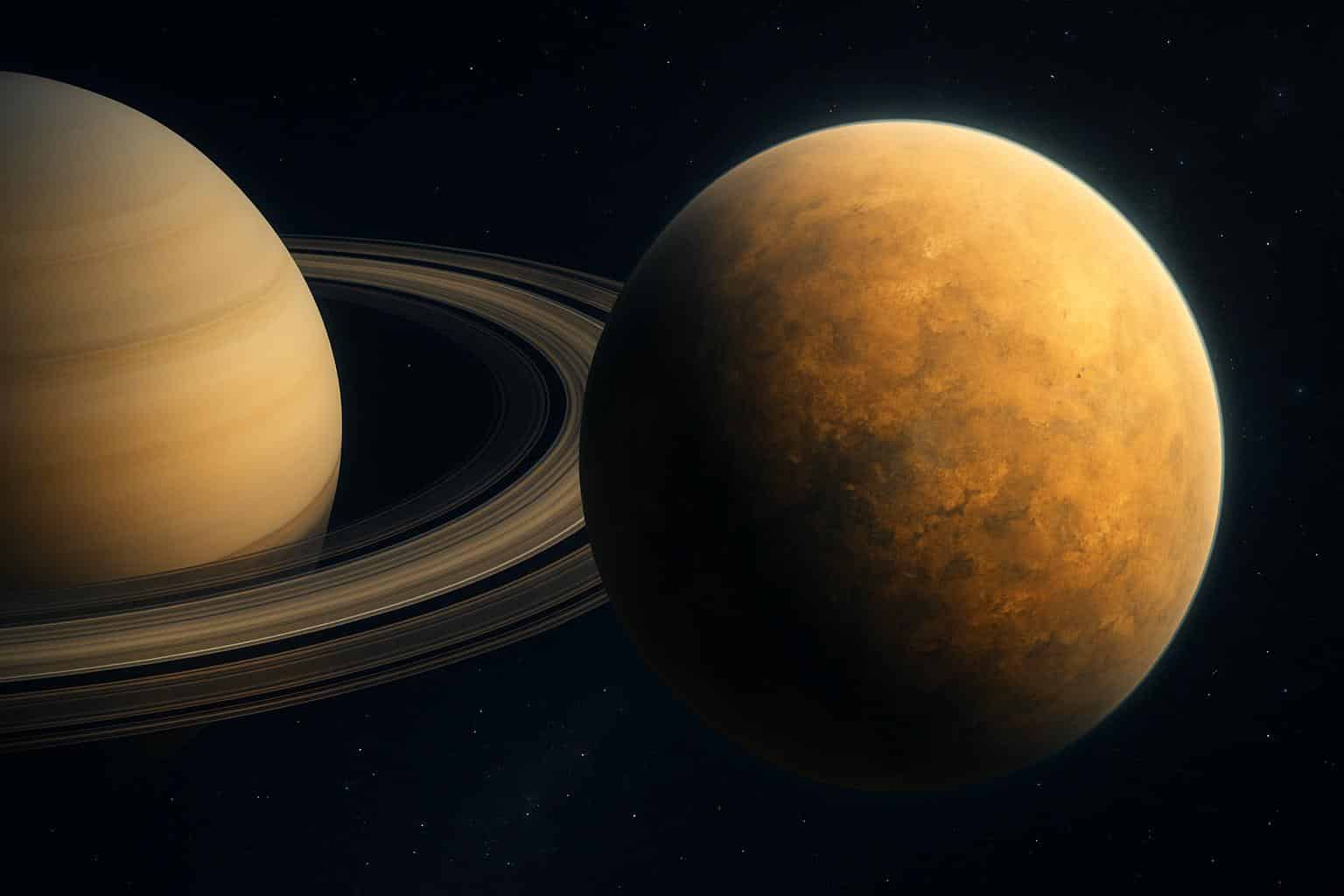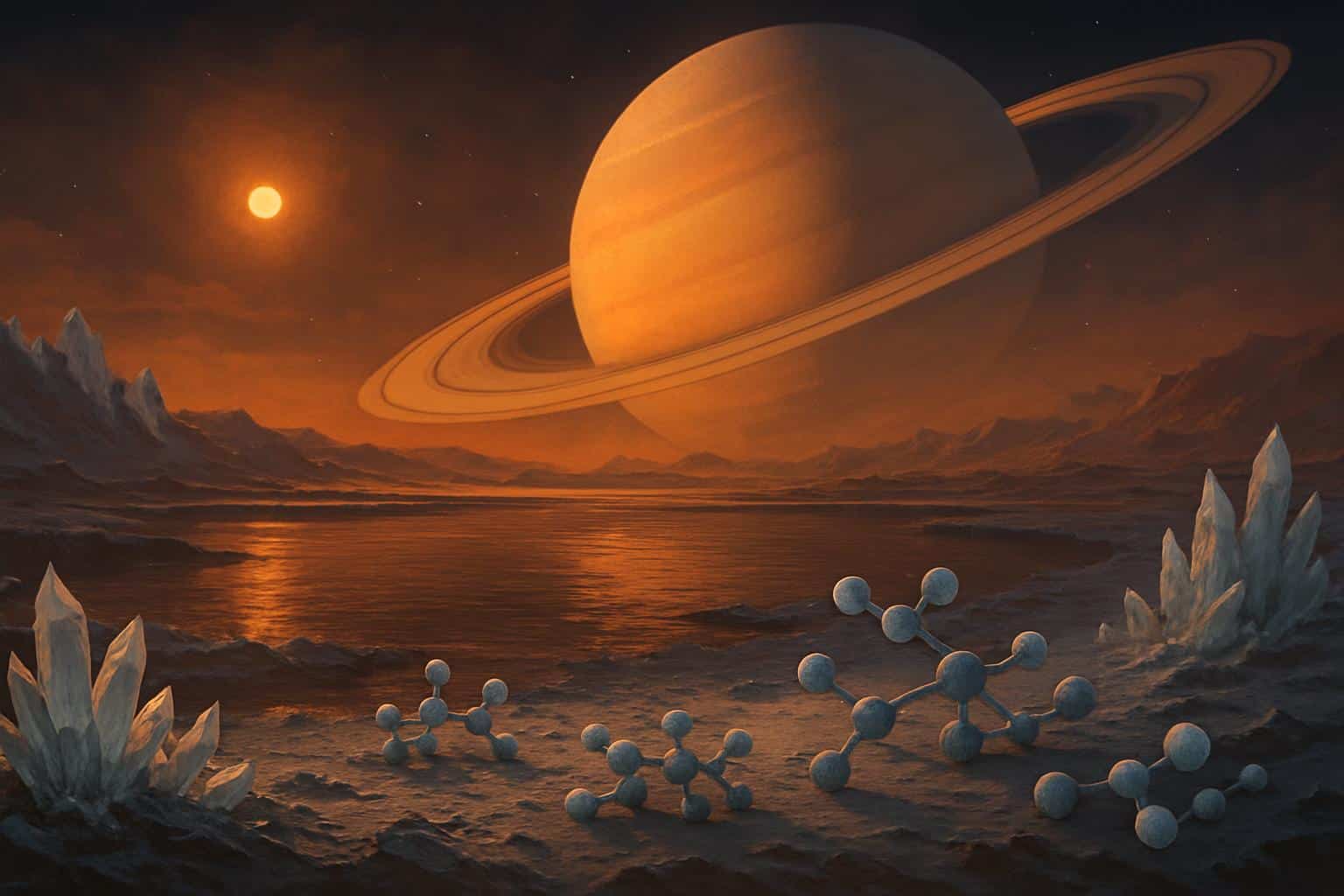Some of the most widely understood rules do bend on Titan. Molecules that avoid one another on Earth instead cooperate in the cold, assembling into shared crystals that subvert common ideas about what mixes with what and how life’s precursors could form beyond our planet, researchers report in experiments meant to mimic its cryogenic surface.
Why Titan Breaks the Rules of Solubility
On Earth, the “like dissolves like” rule of thumb is a workhorse: Polar molecules are likely to dissolve polar ones, and nonpolar molecules should stay with their own. Titan doesn’t follow that script. The surface is around 94 Kelvin, or about −180 Celsius, and covered with lakes of liquid methane and ethane under a nitrogen atmosphere. In that deep freeze, a very polar molecule, hydrogen cyanide (HCN), could combine with nonpolar hydrocarbons to make co-crystals — mixed solids in which each type of molecule has arranged itself into a lattice pattern that’s separate from the other.

That is important because the physical conditions on a planet dictate what chemistry, if any, can even happen. Hydrocarbons such as methane and ethane have ultralow dielectric constants — around 1.7 to 2, whereas a figure of around 80 can be attributed to water at room temperature — making them famously useless in supporting charged or polar species. But at Titan temperatures, thermal motion has slowed to a crawl, and molecules can slot themselves into ever more elaborate structures without needing to completely dissolve. Simply put, structure can take the place of solvation.
In the Lab and on the Computer: Testing Titan’s Chemistry
Researchers at NASA, working with a NASA-led team, mimicked Titan’s conditions in cryogenic chambers and added HCN to methane and ethane. Laser spectroscopy indicated that the molecules themselves were unchanged — no new compounds had formed in solution — but the findings suggested a new crystalline phase had formed. That clue was co-crystals: a physical structure in which different molecules became locked together as one solid.
Chalmers University of Technology researchers who specialize in cyanide chemistry conducted parallel simulations that examined the molecular packing of thousands of additional molecules, with complementary results. Their models pinpointed stable co-crystal structures consistent with the lab signatures and capable of surviving at Titan’s frigid pressures and temperatures. Described in Proceedings of the National Academy of Sciences, the findings suggest that HCN can be encapsulated within hydrocarbon ice crystals made from methane and ethane — something long believed to be impossible according to the classical solvent viewpoint.
The bottom line is not just a kooky anomaly. Co-crystals also can act as molecular scaffolds, depositing otherwise incompatible ingredients right next to one another and producing reactive interfaces when energy — UV photons, cosmic rays or gentle heating — comes into the picture. On Titan, where the sun is faint and chemistry crawls, that sort of enforced proximity is a big deal.
A New Way for Life’s Ingredients to Come Together
Hydrogen cyanide is one of the classic players in prebiotic chemistry. From lab studies dating back some 40 years, HCN chemistry can form amino acids and nucleobases — the building blocks of proteins and RNA/DNA — in conducive circumstances. The challenge has long been coaxing polar and nonpolar actors to hang out together in hydrocarbon neighborhoods. Titan’s co-crystals provide a backdoor: They offer a solid-state environment in which reactive species are placed nanoscale-close to each other, without the necessity for a solvent reminiscent of water.

Astrobiologists see two advantages. For one thing, co-crystals concentrate trace molecules that would be too diffuse in liquids or too sparsely arrayed on grains of ice. Second, they establish ordered environments in which energy input can spread effectively — think of crystal defects and surfaces as tiny catalytic sites. Titan’s geology and climate might together give rise to a stop-start cycle: Deposit organics out of the atmosphere, trap them in co-crystals during cold snaps, then briefly kick reaction into gear as temperatures warm or light exposure increases.
What Cassini Learned and What Dragonfly Might Find
Data from the Cassini-Huygens mission established Titan as an analog to Earth with a twist: dunes carved by winds, lakes and seas at the poles, and active methane weather.
Surface pressure is around 1.5 times Earth’s, and the crust is believed to consist of water ice covered by organic-rich sediments, with a global subsurface ocean beneath. That patchwork gives chemistry many places to live — shores of hydrocarbon lakes, dry lakebeds, dune fields and impact sites that briefly heat up and mix materials.
NASA’s Dragonfly rotorcraft, built by Johns Hopkins Applied Physics Laboratory, will sample these terrains with mass spectrometry and camera imaging. With a project price tag in the multibillion-dollar range, the mission’s scientific success depends on landing somewhere where complex chemistry actually occurs. The new co-crystal results have more specific targets: fine-grained sediments in evaporite basins, frost layers, and mechanically stressed surfaces where crystals break apart and reform — perfect places to trap HCN and other reactive organics together.
Broader Implications for Cold Worlds Beyond Titan
The takeaway stretches beyond Titan. If co-crystals can even put unlikely partners on speaking terms at cryogenic temperatures, then the rulebook for prebiotic chemistry on cold moons and dwarf planets has some revising. Comparable physics could affect chemistry in the upper atmospheres of giant planets, on Kuiper belt objects, or in interstellar ices rich in HCN.
By showing that structure can substitute for solvent, the NASA–Chalmers work broadens the repertoire of chemical pathways available to nature. It doesn’t see Titan as a chemistry dead end but rather as a laboratory in which extremity fosters originality — just the right place, that is, for complex chemistry to begin blazing its first trails.

